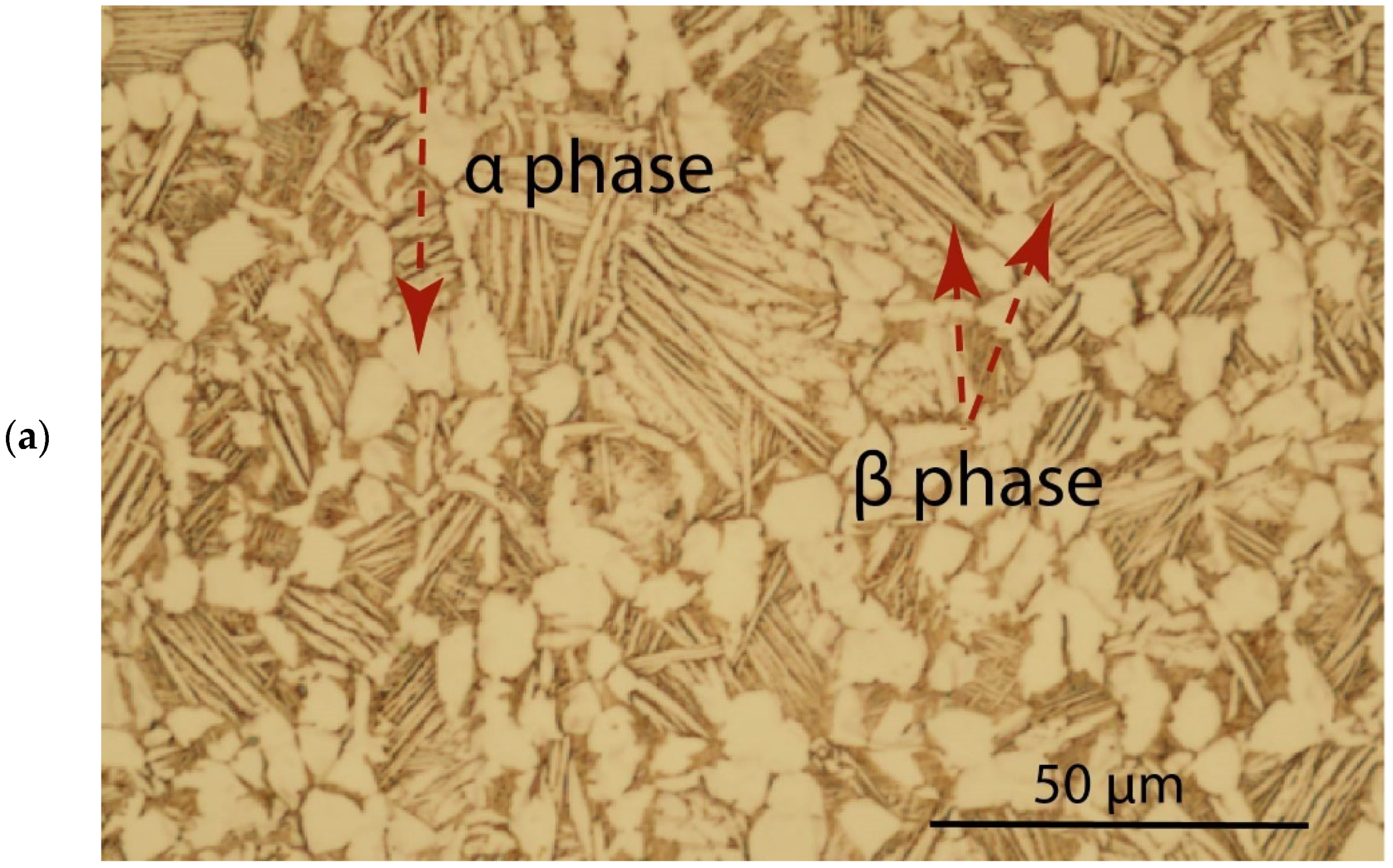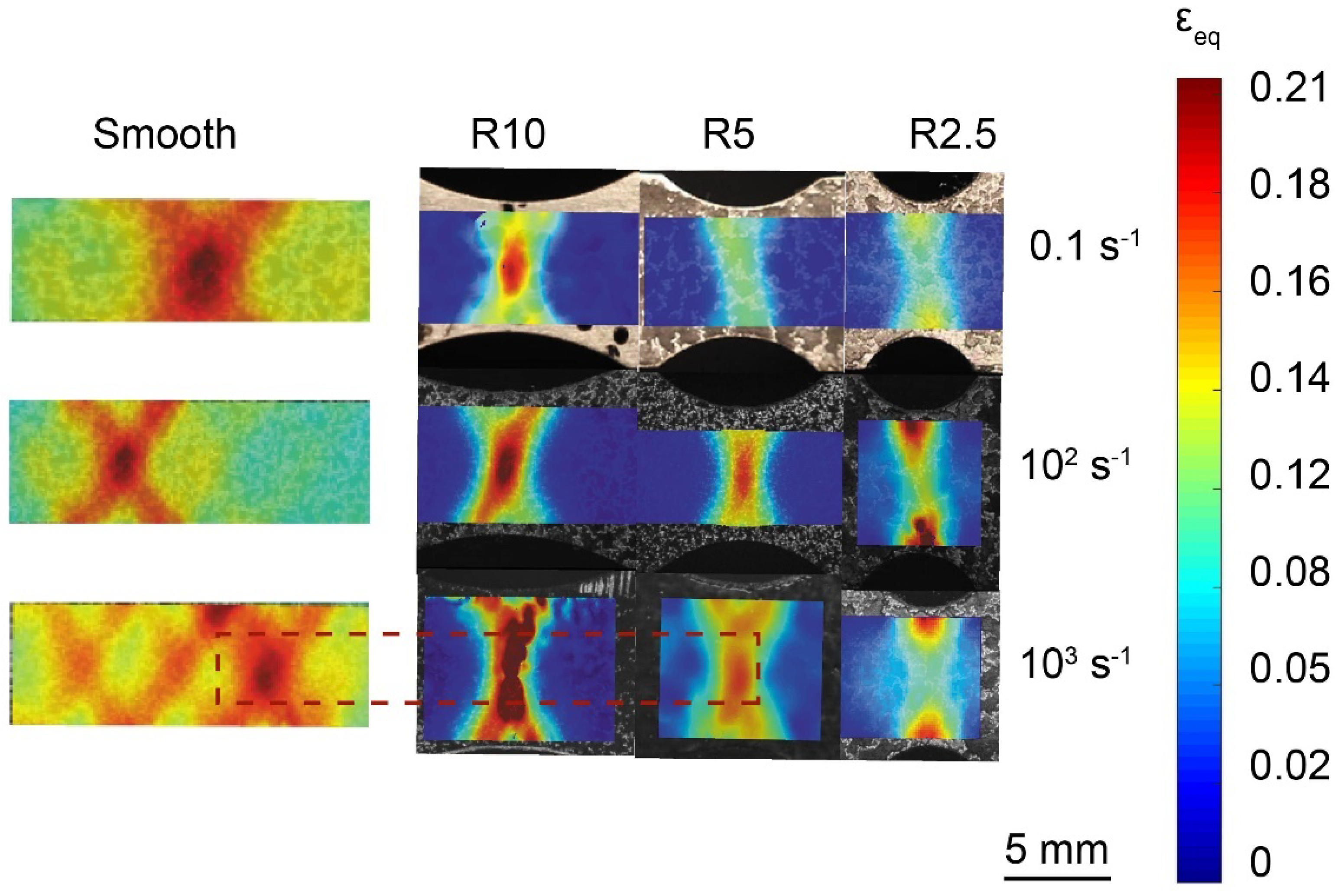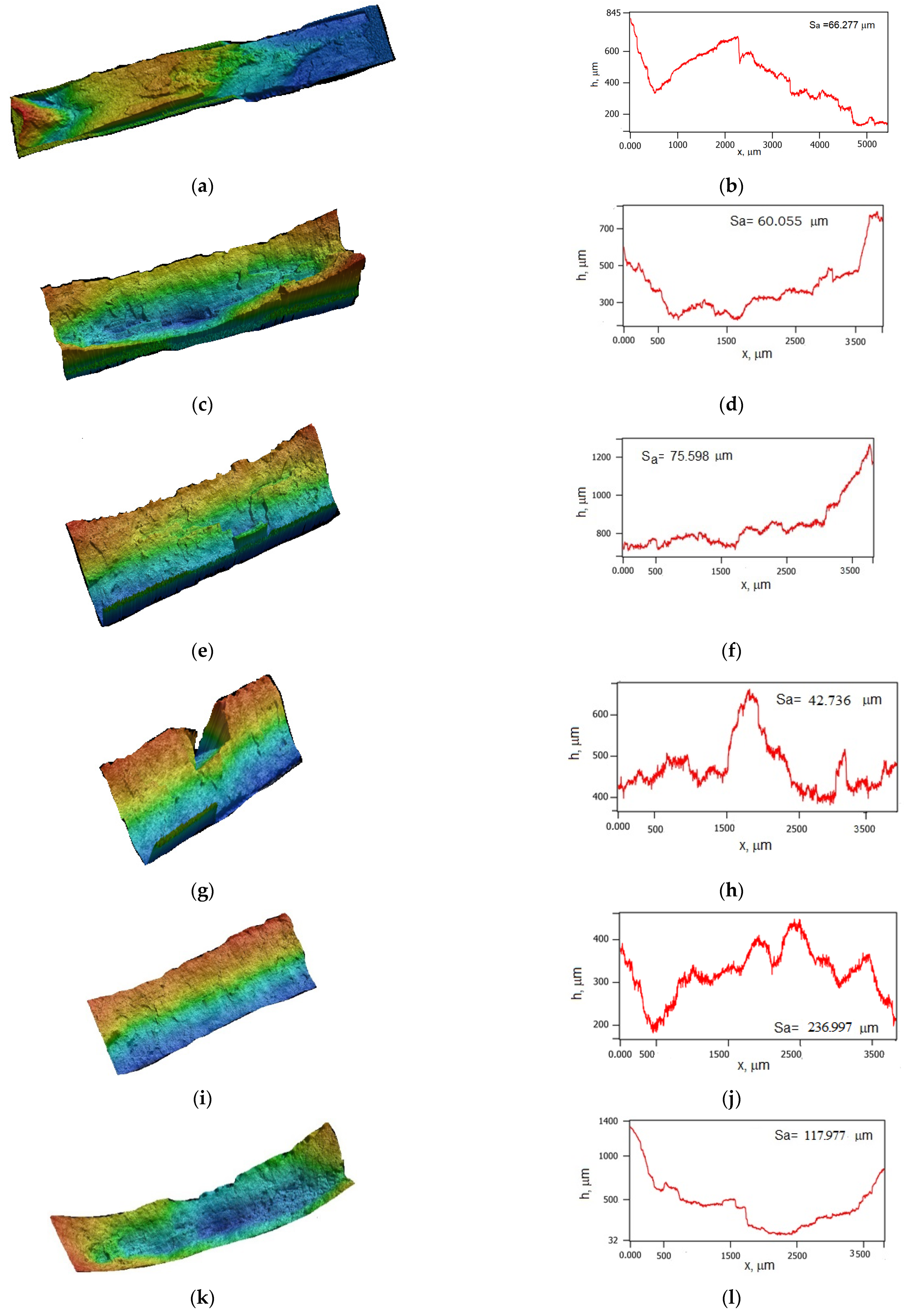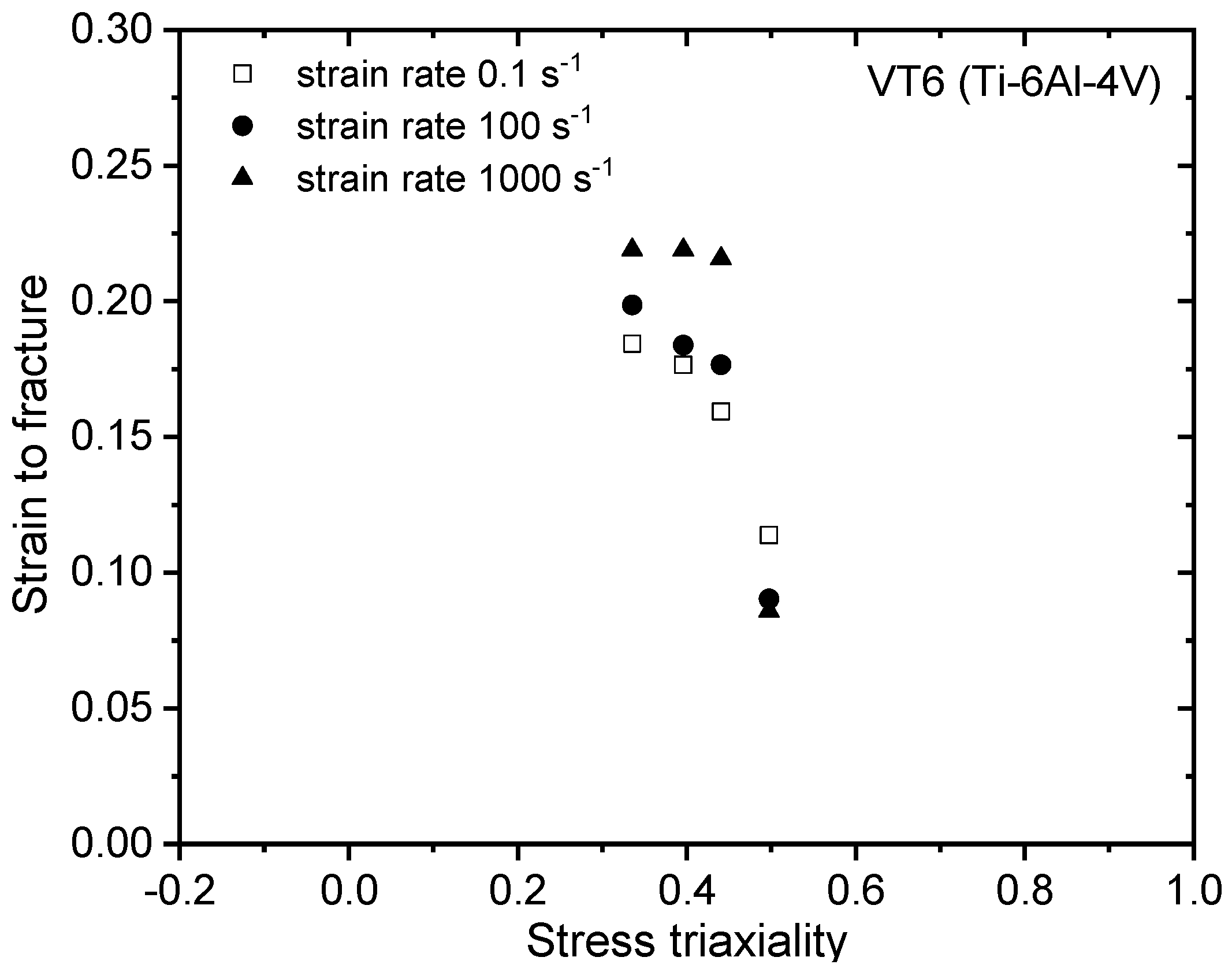Localization of Plastic Deformation in Ti-6Al-4V Alloy
Abstract
:1. Introduction
2. Materials and Methods
3. Results
3.1. Flow Stress and Ultimate Elongation before Fracture
3.2. Analysis of the Topology of the Fracture Surface
4. Discussion
5. Conclusions
- (1)
- The formation of shear bands at high strain rates influences the fracture behavior of the Ti-6Al-4V alloy.
- (2)
- The analysis of the fracture surface indicates the activation of a quasi-cleavage mode of fracture at high strain rates in the Ti-6Al-4V alloy.
- (3)
- At relatively low values of stress triaxiality η and at high strain rates, the ultimate strain to fracture appears to change insignificantly.
- (4)
- High stress triaxiality can cause embrittlement of Ti-6Al-4V subjected to high strain rates.
- (5)
- At high strain rates, the Ti-6Al-4V alloy undergoes fracture by cleavage formation followed by coalescence of nucleated microvoids.
Author Contributions
Funding
Data Availability Statement
Acknowledgments
Conflicts of Interest
References
- Peters, M.; Kumpfert, J.; Ward, C.H.; Leyens, C. Titanium Alloys for Aerospace Applications. In Titanium and Titanium Alloys; Leyens, C., Peters, M., Eds.; Wiley-VCH Verlag GmbH & Co. KGaA: Weinheim, Germany, 2003; pp. 333–350. [Google Scholar]
- Williams, J.C.; Boyer, R.R. Opportunities and Issues in the Application of Titanium Alloys for Aerospace Components. Metals 2020, 10, 705. [Google Scholar] [CrossRef]
- Sharma, S.; Majila, A.N.; Chavan, V.M.; Fernando, D.C.; Patel, R.J.; Babu, S.N. Deformation Response of Titanium Alloy under Static and Dynamic Loading. Procedia Eng. 2017, 173, 1894–1900. [Google Scholar] [CrossRef]
- Allahverdizadeh, N.; Gilioli, A.; Manes, A.; Giglio, M. An experimental and numerical study for the damage characterization of a Ti–6AL–4V titanium alloy. Int. J. Mech. Sci. 2015, 93, 32–47. [Google Scholar] [CrossRef]
- Yan, N.; Li, Z.; Xu, Y.; Meyers, M.A. Shear Localization in Metallic Materials at High Strain Rates. Prog. Mater. Sci. 2020, 119, 100755. [Google Scholar] [CrossRef]
- Nemat-Nasser, S.; Guo, W.; Nesterenko, V.F.; Indrakanti, S.S.; Gu, Y. Dynamic response of conventional and hot isostatically pressed Ti–6Al–4V alloys: Experiments and modeling. Mech. Mater. 2001, 33, 425–439. [Google Scholar] [CrossRef]
- Bisht, A.; Kumar, S.; Pang, K.H.; Zhou, R.; Roy, A.; Silberschmidt, V.V.; Suwas, S. Shear band widening mechanism in Ti–6Al–4V under high strain rate deformation. J. Mater. Res. 2020, 35, 1623–1634. [Google Scholar] [CrossRef]
- Makel, D.D.; Eylon, D. The effect of microstructure on localized melting at separation in Ti-6Al-4V tensile samples. Metall. Mater. Trans. A 1990, 21, 3127–3136. [Google Scholar] [CrossRef]
- Xu, Z.; He, X.; Hu, H.; Tan, P.J.; Liu, Y.; Huang, F. Plastic behavior and failure mechanism of Ti-6Al-4V under quasi-static and dynamic shear loading. Int. J. Impact Eng. 2019, 130, 281–291. [Google Scholar] [CrossRef]
- Li, L.; Jin, T.; Shuang, F.; Li, Z.; Wang, Z.; Ma, W. Micro-Mechanisms of Shear Deformation Localization of Ti6Al4V Alloy under Shear-Compressive Loading Conditions. Materials 2020, 13, 5646. [Google Scholar] [CrossRef]
- Wang, C.; Suo, T.; Li, Y.; Xue, P.; Tang, Z. A New Experimental and Numerical Framework for Determining of Revised J–C Failure Parameters. Metals 2018, 8, 396. [Google Scholar] [CrossRef] [Green Version]
- Wang, B.; Xiao, X.; Astakhov, V.P.; Liu, Z. The effects of stress triaxiality and strain rate on the fracture strain of Ti6Al4V. Eng. Fract. Mech. 2019, 219, 106627. [Google Scholar] [CrossRef]
- Peng, J.; Wang, Y.; Dai, Q.; Liu, X.; Liu, L.; Zhang, Z. Effect of Stress Triaxiality on Plastic Damage Evolution and Failure Mode for 316L Notched Specimen. Metals 2019, 9, 1067. [Google Scholar] [CrossRef] [Green Version]
- Johnson, G.R.; Cook, W.H. Fracture characteristics of three metals subjected to various strains, strain rates, temperatures and pressures. Eng. Fract. Mech. 1985, 21, 31–48. [Google Scholar] [CrossRef]
- Wilson-Heid, A.E.; Furton, E.T.; Beese, A.M. Contrasting the Role of Pores on the Stress State Dependent Fracture Behavior of Additively Manufactured Low and High Ductility Metals. Materials 2021, 14, 3657. [Google Scholar] [CrossRef]
- Armstrong, R.W.; Zerilli, F.J. Dislocation mechanics aspects of plastic instability and shear banding. Mech. Mater. 1994, 17, 319–327. [Google Scholar] [CrossRef]
- Blaber, J.; Adair, B.; Antoniou, A. Ncorr: Open-Source 2D Digital Image Correlation Matlab Software. Exp. Mech. 2015, 55, 1105–1122. [Google Scholar] [CrossRef]
- Skripnyak, V.V.; Skripnyak, E.G.; Skripnyak, V.A. Fracture of Titanium Alloys at High Strain Rates and under Stress Triaxiality. Metals 2020, 10, 305. [Google Scholar] [CrossRef]
- Karolewska, K.; Ligaj, B.; Boroński, D. Strain Analysis of Ti6Al4V Titanium Alloy Samples Using Digital Image Correlation. Materials 2020, 13, 3398. [Google Scholar] [CrossRef] [PubMed]
- Bai, Y.; Wierzbicki, T. A new model of metal plasticity and fracture with pressure and Lode dependence. Int. J. Plast. 2008, 24, 1071–1096. [Google Scholar] [CrossRef]
- Bai, Y.; Teng, X.; Wierzbicki, T. On the Application of Stress Triaxiality Formula for Plane Strain Fracture Testing. J. Eng. Mater. Technol. 2009, 131, 021002. [Google Scholar] [CrossRef]
- Hu, H.; Xu, Z.; Dou, W.; Huang, F. Effects of strain rate and stress state on mechanical properties of Ti-6Al-4V alloy. Int. J. Impact Eng. 2020, 145, 103689. [Google Scholar] [CrossRef]
- Osovski, S.; Srivastava, A.; Ponson, L.; Bouchaud, E.; Tvergaard, V.; Ravi-Chandar, K.; Needleman, A. The effect of loading rate on ductile fracture toughness and fracture surface roughness. J. Mech. Phys. Solids 2015, 76, 20–46. [Google Scholar] [CrossRef]
- Ponson, L.; Cao, Y.; Bouchaud, E.; Tvergaard, V.; Needleman, A. Statistics of ductile fracture surfaces: The effect of material parameters. Int. J. Fract. 2013, 184, 137–149. [Google Scholar] [CrossRef]
- Needleman, A.; Tvergaard, V.; Bouchaud, E. Prediction of Ductile Fracture Surface Roughness Scaling. J. Appl. Mech. 2012, 79, 031015. [Google Scholar] [CrossRef]
- Chang, Q.; Chen, D.L.; Ru, H.Q.; Yue, X.Y.; Yu, L.; Zhang, C.P. Three-dimensional fractal analysis of fracture surfaces in titanium–iron particulate reinforced hydroxyapatite composites: Relationship between fracture toughness and fractal dimension. J. Mater. Sci. 2011, 46, 6118–6123. [Google Scholar] [CrossRef]
- Mandelbrot, B.; Passoja, D.; Paulay, A.J. Fractal character of fracture surfaces of metals. Nature 1984, 308, 721–722. [Google Scholar] [CrossRef]
- Liang, H.; Pan, F.S.; Chen, Y.M.; Yang, J.J.; Wang, J.F.; Liu, B. Influence of the Strain Rates on Tensile Properties and Fracture Interfaces for Mg-Al Alloys Containing Y. Adv. Mater. Res. 2011, 284, 1671–1677. [Google Scholar] [CrossRef]
- Azinfar, M.J.; Ghazvinian, A.H.; Nejati, H.R. Assessment of scale effect on 3D roughness parameters of fracture surfaces. Eur. J. Environ. Civ. Eng. 2016, 23, 1–28. [Google Scholar] [CrossRef]
- Carney, L.R.; Mecholsky, J.J., Jr. Relationship between fracture toughness and fracture surface fractal dimension in AISI 4340 steel. Mater. Sci. Appl. 2013, 4, 258–267. [Google Scholar] [CrossRef] [Green Version]
- Ruiz de Sotto, M.; Doquet, V.; Longère, P.; Papasidero, J. Anisotropic, rate dependent ductile fracture of Ti-6Al-4V alloy. Int. J. Damage Mech. 2021, in press. [Google Scholar] [CrossRef]
- Ruiz de Sotto, M.; Longère, P.; Doquet, V.; Papasidero, J. A constitutive model for a rate and temperature-dependent, plastically anisotropic titanium alloy. Int. J. Plast. 2020, 134, 102777. [Google Scholar] [CrossRef]








| Dimensions Afs, µm × µm | Parameter Values | Sa, µm | Sz, µm | Str | Spc, 1/mm | Sdr | Strain Rate, s−1 | Notch Radius of Specimen, mm |
|---|---|---|---|---|---|---|---|---|
| 754.326 × 5422.843 | Max | 93.956 | 548.295 | 0.671 | 10,559.975 | 6.601 | 1000 | Smooth |
| Min | 38.599 | 287.055 | 0.514 | 9296.000 | 4.771 | |||
| Average | 66.277 | 417.675 | 0.593 | 9927.987 | 5.686 | |||
| Std. Dev | 27.678 | 130.620 | 0.078 | 631.987 | 0.9147 | |||
| 647.931 × 3760.711 | Max | 92.319 | 522.629 | 0.128 | 14,336.275 | 12.67 | 1000 | 10 |
| Min | 33.180 | 188.105 | 0.113 | 12,583.356 | 8.555 | |||
| Average | 60.055 | 370.053 | 0.118 | 13,613.336 | 10.90 | |||
| Std. Dev | 24.443 | 138.139 | 0.007 | 747.836 | 1.730 | |||
| 614.847 × 3812.108 | Max | 97.991 | 575.645 | 0.387 | 24,276.398 | 29.61 | 1000 | 5 |
| Min | 53.723 | 405.401 | 0.080 | 18,001.793 | 18.87 | |||
| Average | 75.598 | 511.757 | 0.188 | 21,795.751 | 25.38 | |||
| Std. Dev | 18.076 | 75.712 | 0.140 | 2724.733 | 4.669 | |||
| 308.593 × 3842.977 | Max | 57.030 | 390.964 | 0.062 | 21,810.949 | 25.86 | 1000 | 2.5 |
| Min | 31.290 | 215.225 | 0.048 | 15,847.240 | 13.77 | |||
| Average | 42.736 | 316.093 | 0.057 | 19,288.885 | 20.88 | |||
| Std. Dev | 10.700 | 74.063 | 0.006 | 2520.010 | 5.162 | |||
| 292.560 × 3819.958 | Max | 261.051 | 979.485 | 0.410 | 21,296.474 | 23.75 | 100 | Smooth |
| Min | 201.801 | 817.840 | 0.316 | 17,829.274 | 17.67 | |||
| Average | 236.997 | 907.937 | 0.361 | 19,751.918 | 21.11 | |||
| Std. Dev | 25.440 | 67.282 | 0.039 | 1440.505 | 2.545 | |||
| 1367.196 × 3800.668 | Max | 127.772 | 774.560 | 0.470 | 20,955.892 | 24.26 | 100 | 10 |
| Min | 111.355 | 648.745 | 0.453 | 17,592.438 | 17.80 | |||
| Average | 117.977 | 692.050 | 0.464 | 19,819.734 | 21.96 | |||
| Std. Dev | 7.068 | 58.367 | 0.008 | 1575.044 | 2.947 | |||
| 174.703 × 2609.916 | Max | 255.927 | 964.900 | 0.506 | 22,991.209 | 26.68 | 100 | 5 |
| Min | 212.121 | 831.245 | 0.424 | 20,005.690 | 22.05 | |||
| Average | 233.770 | 885.752 | 0.472 | 21,783.518 | 24.79 | |||
| Std. Dev | 17.887 | 57.279 | 0.035 | 1283.777 | 1.988 | |||
| 623.559 × 4957.359 | Max | 225.794 | 875.120 | 0.447 | 17,426.704 | 17.47 | 100 | 2.5 |
| Min | 104.816 | 631.075 | 0.346 | 15,618.083 | 14.62 | |||
| Average | 163.100 | 735.469 | 0.404 | 16,427.935 | 16.11 | |||
| Std. Dev | 45.400 | 96.833 | 0.041 | 735.078 | 1.030 |
Publisher’s Note: MDPI stays neutral with regard to jurisdictional claims in published maps and institutional affiliations. |
© 2021 by the authors. Licensee MDPI, Basel, Switzerland. This article is an open access article distributed under the terms and conditions of the Creative Commons Attribution (CC BY) license (https://creativecommons.org/licenses/by/4.0/).
Share and Cite
Skripnyak, V.V.; Skripnyak, V.A. Localization of Plastic Deformation in Ti-6Al-4V Alloy. Metals 2021, 11, 1745. https://doi.org/10.3390/met11111745
Skripnyak VV, Skripnyak VA. Localization of Plastic Deformation in Ti-6Al-4V Alloy. Metals. 2021; 11(11):1745. https://doi.org/10.3390/met11111745
Chicago/Turabian StyleSkripnyak, Vladimir V., and Vladimir A. Skripnyak. 2021. "Localization of Plastic Deformation in Ti-6Al-4V Alloy" Metals 11, no. 11: 1745. https://doi.org/10.3390/met11111745
APA StyleSkripnyak, V. V., & Skripnyak, V. A. (2021). Localization of Plastic Deformation in Ti-6Al-4V Alloy. Metals, 11(11), 1745. https://doi.org/10.3390/met11111745





